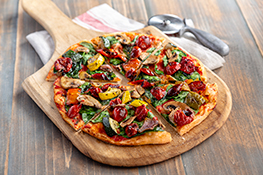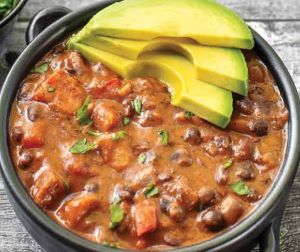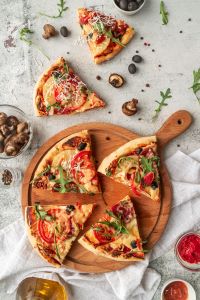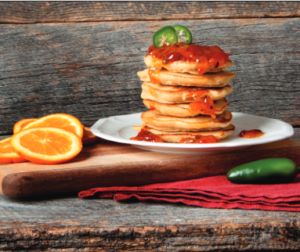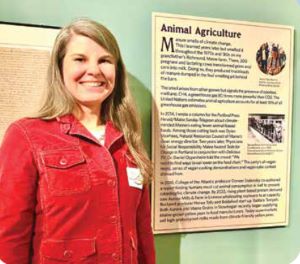Posted on
December 29, 2023 by
The VRG Blog Editor
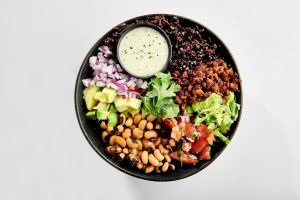
photo from Brick City Vegan
The Vegetarian Resource Group maintains an online Guide to Vegan/Vegetarian Restaurants in the USA and Canada. Here are some recent vegan restaurant additions. The entire guide can be found here: http://www.vrg.org/restaurant/index.php
To support the updating of this online restaurant guide, please donate at: www.vrg.org/donate
Here are some new additions to VRG’s guide:
Black Market Meats, 15613 Detroit Ave., Lakewood, OH 44107
Located near Kauffman Park in Lakewood (west Cleveland area), this “grab-and-go” restaurant features a rotating menu of soups, salads, and sandwiches with vegan deli meats, cheeses, and condiments, all made from scratch. A few notable items include broccoli salad, jambalaya, and stuffed peppers. Online ordering is available.
Brick City Vegan, 2 South Willow St., Montclair, NJ 07042
Brick City Vegan offers healthy food, using locally-sourced ingredients, in a casual, friendly manner, thereby fulfilling its mission of proving that being vegan can be easy. The only hard part is trying to decide which items to order from the menu that celebrates American regional foods, such as the Southern-inspired biscuits, the Philly cheesesteak, or the all-American burger. The country biscuits are baked daily from scratch. And make sure to leave room for a fruit shake, like the Piña Colada made with coconut milk, pineapple, banana, lime and agave.
Monster Baby Donuts, East Market, 212 Kelton Ave., Columbus, OH 43205
Having been inspired by the founder and her family’s food allergies, Monster Baby Donuts has opened a permanent space in the East Market food hall. The scrumptious mini donuts are not only vegan but also gluten-free, and they are so cute that you may be tempted—albeit briefly—to admire and not bite into them. But it will be hard to resist with such offerings as Death by Chocolate (a triple chocolate donut); the SunButter Buckeye Donut (a double chocolate donut with a SunButter glaze); and the Cinnamon Roll Donut (featuring a cinnamon vanilla glaze and a vegan buttercream). If you are able to distract yourself from the donut offerings, other menu options include items such as a chocolate-covered pretzel, fudge, and a chocolate chip cookie sandwich.
PLANTA, 11754 San Vicente Blvd., Los Angeles, CA 90049
Planta’s wide ranging menu should appeal to many different palates and cravings. Here’s what’s for dinner. Two of the many imaginative Sushi choices are Ahi Watermelon Nigri with ginger and citrus soy or Crispy Mushroom Hand Roll sauced with the savory, sweet heat of Korean gochujang, pickled ginger and eggplant unagi–a vegan interpretation of eel. One example from Chilled & Raw is Avocado Lime Tartare featuring beetroot tuna, pine nuts, capers, citrus soy, sesame, cilantro and taro chips. Some Signature dishes include Tagliatelle pasta in truffle-mushroom cream and bread crumbs and Spicy Lumaconi Pasta with tomato rosé sauce, cashew mozzarella, almond parmesan, and calabrese chili. Brick Oven tempts with choices like Leek Bianca garlic cream, cashew mozzarella and mushroom bacon, or Vodka Pizza–tomato cream, cashew mozzarella, pesto, basil, and chili bomba. Snack & Share options include Bang Bang Broccoli with sweet chili peanut sauce, or Coconut Ceviche—a tropical melange of pineapple, coconut milk, sweet potato, corn nuts, cilantro, lime, and avocado. They offer Daily Specials too. Lunch features some of the dinner menu ítems, but also includes more Wraps, and some different Signature dishes such as Funghi Salad comprised of butternut squash, chick n’ fried mushrooms, almond parmesan and a balsamic glaze. Many of the Lunch & Dinner ítems show up for their weekend Brunch, but there’s also cinnamon glazed Monkey Bread, a spicy spinach artichoke Omelet, Banana Waffle with roasted pecans, French Toast with granola, and more. For Dessert there’s Keylime Cheesecake, Chocolate Brownie, and more.
PlanTita’s Kitchen, 1950 W. Willow St., Long Beach, CA 90810
Come on down to PlanTita’s Kitchen where you are sure to feel right at home! This establishment serves veganized versions of Mexican dishes including an enmolada plate, elote fried ribs, pozole verde, flauta plate, and even tres leches cake. With recipes passed down through generations, this restaurant prides itself on showcasing vegan Mexican dishes without sacrificing the classic flavors. Come enjoy a meal under the dim lights and music surrounded by Latino heritage/culture decorations. Make sure to hi to the portrait of Frida Kahlo.
Vegan Wangs, 1038 White St. SW, Atlanta, GA 30310
An entirely vegan takeout, delivery, and catering service that offers a variety of hearty options such as wheat protein-based chick’n wings, chick’n fingers with fried oyster mushrooms, salads with coconut-based feta, drinks, and desserts. The wings are offered in a selection of distinctive flavors, including Lemon Buffalo, Thai Sweet Chili, BBQ, Jerk, and Mango Habenero. Moreover, they are available in 5, 6, 10, 12, and 20-piece sizes that can include French fries. Please kindly note that Vegan Wangs is not a sit-down restaurant. Orders are placed on their website, Uber Eats, Door Dash, or Grubhub; then an estimated time is given. In that vein, the pickup location might be hard to find. If you are facing the 1038 building from the entrance, it’s the first green door on the left with yellow rails and a ramp. Kindly knock on the door, and someone will assist you.
Vice Burger, 1515 W. Magnolia Ave., Fort Worth, TX 76104
At Vice Burger, the classic burger joint meets the modern magic of plant-based meats to offer a menu chock full of your fast-food favorites, including burgers, hot dogs, chicken nuggets, fries and tots, and, of course, milkshakes. The Vice Dog is made using a Field Roast Stadium Link, while the burgers are made using either Beyond or Impossible patties. The Smoky Bacon Vice Burger is a menu star, made with vegan bacon slices, on a butter toasted sesame bun, with a smoky Vice sauce, PepperJack cheese, and lettuce, tomato, and grilled onions. Shakes are made using NadaMoo vegan ice cream from Austin, with flavor options of Cookies & Cream, Double Chocolate, and Mint Chocolate Chip. With offerings like this, Vice Burger is clearly living up to its slogan: “Have your vice and eat it too.”
